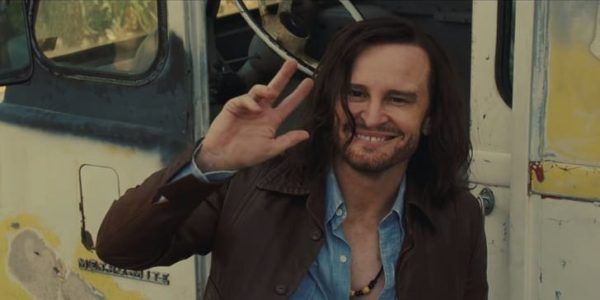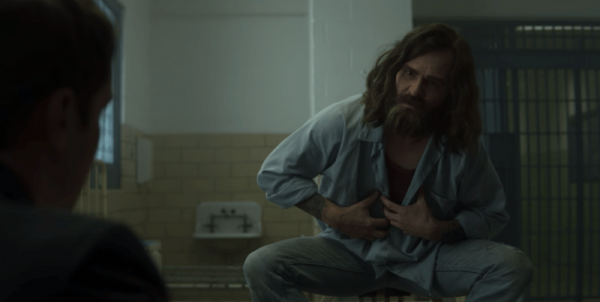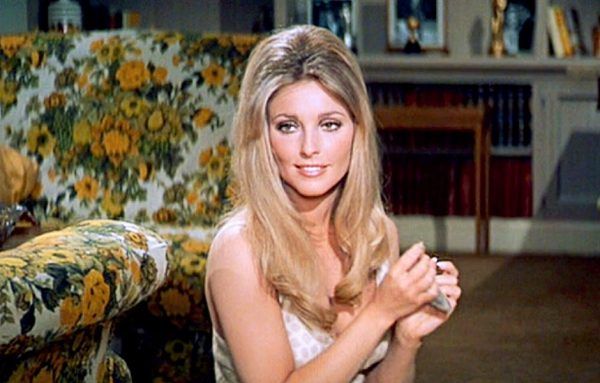With the release of both Quentin Tarantino’s Once Upon a Time...in Hollywood and the second season David Fincher's true-crime Netflix drama Mindhunter, the name Charles Manson is, once again, on everyone’s lips. Manson never really went away, cementing his infamy on August 9, 1969, but it’s through these recent pop culture reexaminations that it’s worth looking at who Manson was, what he did, and why he’s (unfortunately) endured in our collective consciousness for the last 50 years.
The man known as Charles Manson was initially brought into this world as “no name Maddox,” the result of his 16-year-old mother Kathleen Maddox’s inability (or unwillingness) to name him. She eventually gave him the name Charles Milles Maddox. Kathleen Maddox was an alcoholic and a prostitute, and it’s unclear whether Manson ever knew his birth father. Maddox’s inability to control her drinking and her penchant for crime caused the marriage to dissolve when Manson was three. When the child was five, Maddox was arrested for a burglary gone wrong and was sentenced to five years in prison. Charles Manson was left to an aunt and uncle until his mother was paroled in 1942.
When his mother was released, she couldn’t control her wayward son, who by this time was known for playing truant and stealing from both his home and local businesses. Maddox sent her son to the Gibault School for Boys in Terre Haute, Indiana, possibly hoping that the Catholic priests would straighten him out. Manson eventually fled to the streets, committing petty burglaries to support himself.
In 1952, Manson’s crimes took a turn for the violent. He was charged with raping a boy at knifepoint and eventually sent to a maximum-security reform school in Ohio. After he was let out for good behavior, he met a small-time hospital waitress named Rosalie Willis. The two were married and moved to Los Angeles (in a car Manson had stolen). Rosalie was prepared to give birth to the couple’s first child. Manson was charged with stealing the car and transporting it across state lines and after a series of probation violations he was sent to the infamous Terminal Island prison in San Pedro, California to serve three years. Willis gave birth to Charles Manson, Jr. but soon moved in with another man and filed for divorce from Manson.
After, Manson was paroled in 1958 and turned to pimping out young women, many of them runaways from wealthy families. He was still getting in trouble with the law throughout the ‘60s, generally for federal crimes like violating the Mann Act (crossing state lines to commit a crime) and check fraud. By 1967 Manson had spent over half his life in various reformatories and prisons. He also managed to marry for the second time, a woman named Leona who claimed to bear him another child, named Charles Luther, whose paternity remains in dispute.
By 1967, Manson wanted to start over and moved to Berkeley, California, where he took up playing the guitar and amassing a group of followers, usually young women. He started to profess that his will was on par with that of Jesus Christ and that his followers were reincarnations of the original Christians that followed Jesus. He began traveling throughout the U.S. and also had another child. From this point out, Manson’s life becomes a series of half-truths, rumors, and apocryphal storytelling. Allegedly, Dennis Wilson of the Beach Boys started dating two of Manson’s followers and invited Manson to a few parties, only to discover that the strange hippie he met was living in his home, along with 12 other people. Undeterred, Wilson offered to pay for studio time, to let Manson record music in the hopes of getting a record deal, and also introduced Manson to other people in the music industry like Terry Melcher.
Wilson’s manager, uninterested in having his client’s house taken over, evicted Manson and his group, who eventually took over the dusty former movie studio, Spahn Ranch. The Ranch’s owner, George Spahn, allowed the group to live there, with Manson supplying the older man with sex from the numerous women on the property. By 1968, Manson was declaring that a race war would soon break out, bringing on the apocalypse, and that Manson and his followers would be the only ones left standing. He became obsessed with the Beatles, whom he believed talked in code about this presumed war. The group, he declared, would need to record an album to trigger this, an event he called “Helter Skelter,” and he believed Melcher would help him get it out there. But Melcher never arrived.
The events that kicked off “Helter Skelter” started on July 25, 1969, when three of Manson’s followers murdered a music teacher and Ph.D. student named Gary Hinman. The group believed Hinman had a $21,000 inheritance he would give them, and when that turned out to be untrue, Bobby Beausoleil stabbed him to death. Another member, Susan Atkins, wrote the words “Political piggy” on the wall in Hinman’s blood. Two days later, Manson declared it was finally time to kickstart the race war he had been talking about.
On the night of August 8, four of Manson’s followers, on his orders, murdered actress Sharon Tate, eight months pregnant with her son Paul, Tate’s friends Jay Sebring, Abigail Folger, and Voytek Frykowski. They also shot 18-year-old Steven Parent, a young man visiting an acquaintance in Tate’s guest house that evening. The group was stabbed multiple times and, like the Hinman murder, the word “pig” was written on a wall in Tate’s blood. The next night, grocery store executive Leno LaBianca and his wife, Rosemary, were killed. During this murder, Manson himself was actually present, going inside the LaBianca home to tie the pair up. This murder, compared to the previous night, was far more violent and coordinated, with Manson’s followers using all manner of weapons to kill their victims, carving the words “war” into Leno LaBianca’s abdomen. A third murder was planned but ended up being abandoned after Linda Kasabian, one of Manson’s followers, knocked on the wrong door.
Los Angeles was thrown into a panic, though initially, the Los Angeles Police Department assumed the Tate killings were the result of a drug deal gone wrong. The LaBianca murder, discovered 19 hours after the Tate killings, was perceived as a separate crime. A series of leads, coupled with members of Manson’s family talking to various people in their lives, led to the connection of the two crimes and on December 1, 1969, the LAPD arrested Charles “Tex” Watson, Patricia Krenwinkle, and Linda Kasabian for the murder of Sharon Tate and her friends. Manson himself was already in custody.
The trial, starting on June 15, 1970, was lengthy and disturbing. The Manson “girls,” as they were dubbed, often came in singing and holding hands, carving an “X” into their foreheads. Manson, at one point, attempted to attack a judge and often created interruptions. Regardless, the prosecution maintained that, despite the fact he never killed anyone himself, Manson ordered his followers to murder in the hopes of creating a war between white and black people. The accused women all maintained that Manson had nothing to do with it, which their attorneys argued was proof of brainwashing by Manson. It proved fruitless as on January 25, 1971, sentenced Atkins, Krenwinkle, Van Houten, and Manson to death. When the death penalty was overturned in 1972 by the state of California, Manson was given life in prison.
Manson was put into the general population in the California Medical Facility in Vacaville where he was doused in paint thinner and set on fire by a fellow inmate in 1984, which compelled him to be put in isolation. He would move to at least four different prisons throughout these final decades of his life. In 2014, it was revealed Manson was engaged to a 26-year-old woman named Afton Elaine “Star” Burton, who had been visiting him in prison for nine years. The marriage never took place, presumably because Manson realized Brown only wanted to lay claim to his body when he died (though she denied it).
On January 1, 2017, Manson went to the hospital after having gastrointestinal bleeding. He would ultimately die from cardiac arrest and colon cancer four days later at the age of 83.
With this year marking the 50th anniversary, it’s unsurprising that Manson’s legacy has endured. But even before 2019 Manson remained a talking point. He is one of the embodiments of pure evil, not just for the murders done in his name but for the bizarre power and mastery he had over people. Books, documentaries, and movies have been made over the decades in the hopes of “figuring out” why he was so compelling. We still don’t have a clear answer, so there’s no doubt we’ll be talking about him, in some way, for another 50 years to come.
For more on Once Upon a Time in Hollywood and Mindhunter, check out the links below.
- ‘Mindhunter’: What You Need to Remember from Season 1 Before You Watch Season 2
- Retired FBI Profiler and ‘Mindhunter’ Author John Douglas on ID’s ‘Serial Killer’ Series
- Quentin Tarantino Responds to Controversy Surrounding ‘Once Upon a Time’s Bruce Lee Scene
- Why I’m Still Wrestling with the Ending of ‘Once Upon a Time…in Hollywood’




